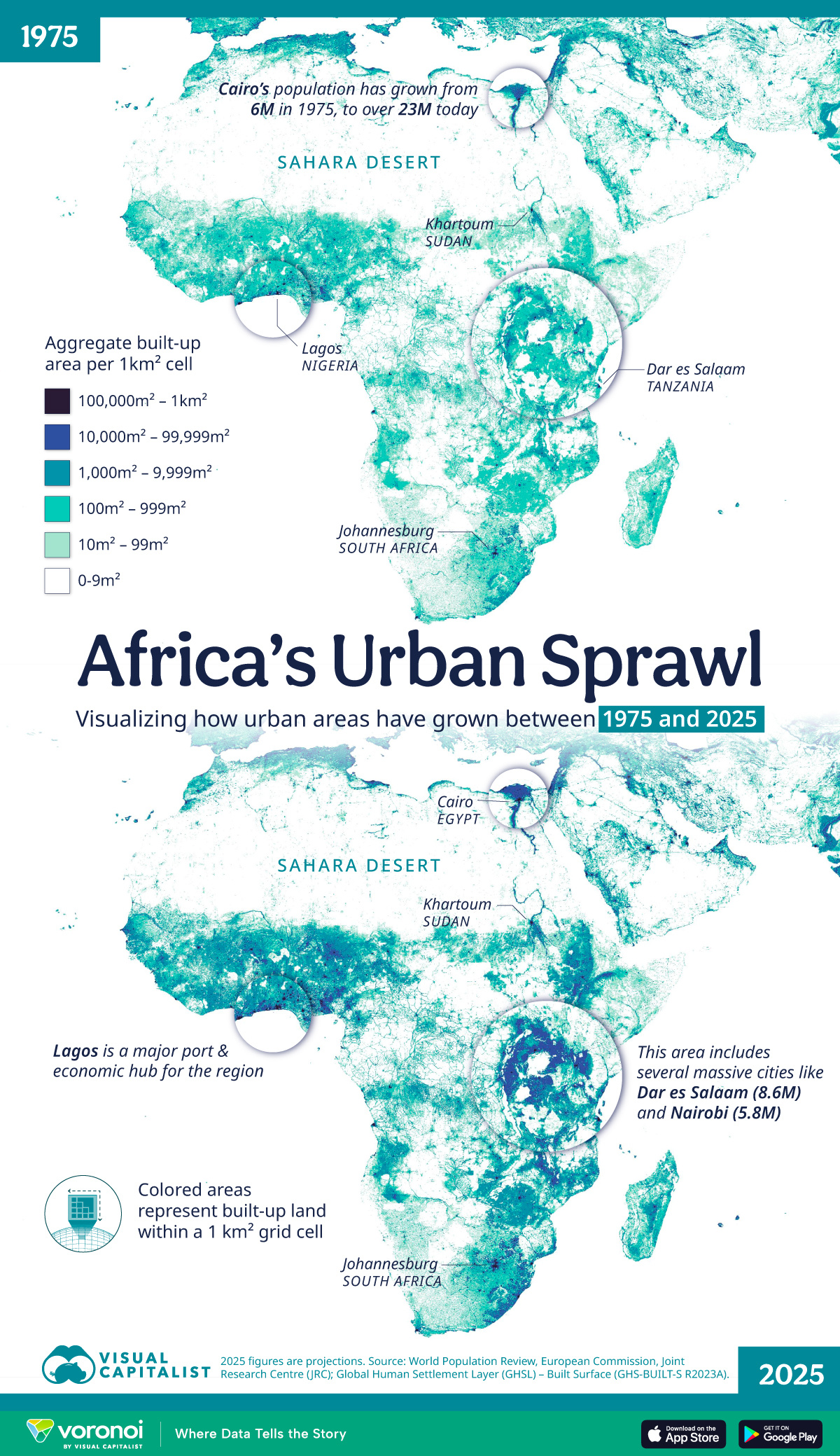Mapped: Urban Sprawl in Africa (1975 to 2025)
This was originally posted on our Voronoi app. Download the app for free on iOS or Android and discover incredible data-driven charts from a variety of trusted sources.
Key Takeaways
- Africa’s urban footprint has expanded significantly since 1975, with cities like Lagos and Cairo emerging as dominant hubs.
- Vast regions such as the Sahara remain sparsely developed, emphasizing how geography and climate shape urban growth.
Africa is urbanizing at an impressive pace, with cities growing rapidly in both population and geographical footprint. This expansion has reshaped economies, infrastructure, and regional dynamics.
To see what this change looks like, we’ve visualized the amount of built-up land across Africa at two points in time: 1975 and 2025 (projected).
Data & Discussion
The data for this visualization comes from the Global Human Settlement Layer (GHSL), a programme of the European Union. It tracks the spatial growth of urban settlements, showing how population centers have expanded since 1975 and projecting trends through 2025.
Please note that the GHSL dataset is not in a format that can be shown in a table. Instead, we’ve listed Africa’s top 20 cities (metro areas) by population below.
| City | Country | Population (2025) |
|---|---|---|
| Cairo |  Egypt Egypt |
23,074,200 |
| Kinshasa |  DR Congo DR Congo |
17,778,500 |
| Lagos |  Nigeria Nigeria |
17,156,400 |
| Luanda |  Angola Angola |
10,027,900 |
| Dar es Salaam |  Tanzania Tanzania |
8,561,520 |
| Khartoum |  Sudan Sudan |
6,754,180 |
| Johannesburg |  South Africa South Africa |
6,444,580 |
| Abidjan |  Ivory Coast Ivory Coast |
6,056,880 |
| Addis Ababa |  Ethiopia Ethiopia |
5,956,680 |
| Alexandria |  Egypt Egypt |
5,807,050 |
| Nairobi |  Kenya Kenya |
5,766,990 |
| Cape Town |  South Africa South Africa |
5,063,580 |
| Yaounde |  Cameroon Cameroon |
4,854,260 |
| Kano |  Nigeria Nigeria |
4,645,320 |
| Douala |  Cameroon Cameroon |
4,346,420 |
| Kampala |  Uganda Uganda |
4,265,160 |
| Antananarivo |  Madagascar Madagascar |
4,228,980 |
| Abuja |  Nigeria Nigeria |
4,209,940 |
| Ibadan |  Nigeria Nigeria |
4,144,130 |
| Kumasi |  Ghana Ghana |
4,036,230 |
| Casablanca |  Morocco Morocco |
4,012,310 |
| Port Harcourt |  Nigeria Nigeria |
3,793,780 |
| Dakar |  Senegal Senegal |
3,658,640 |
The Rise of Africa’s Mega-Cities
Cairo (Egypt), Kinshasa (DRC), and Lagos (Nigeria) dominate the continent’s urban hierarchy. Cairo leads with over 23 million people, while Kinshasa and Lagos each surpass 17 million.
These cities have grown into global-scale megacities, pulling in migration from rural areas and smaller towns.
Their growth also reflects broader trends of economic opportunity and population pressure. For example, Egypt and Nigeria are two of Africa’s top countries by GDP.
Geographic Limits to Urbanization
Urban sprawl in Africa is most pronounced in the southern part of the continent, contrasting sharply with sparsely populated regions such as the Sahara.
The Sahara, Sahel, and parts of the Congo Basin act as natural barriers to urban sprawl. Coastal hubs and river valleys attract concentrated populations, while deserts and arid zones remain largely empty.
Learn More on the Voronoi App 
If you enjoyed today’s post, check out The Five Countries Responsible for Half of African GDP on Voronoi, the new app from Visual Capitalist.

